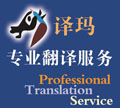 |
USUARIO PUB: transhorsa |
Informacion Personal | Primer nombre:
John | Segundo nombre:
| Apellido:
Jones | Fecha de suscripcion:
06/24/2008 | Direccion de correo:
Debes iniciar sesion para ver! | Website:
http://www.transhorsa.org | Genero:
Masculino | Perfil:
We are a professional language translation company dealing with document translation, text translation and translation outsourcing services by our native translation experts. As an international translation vender, we provide accurate, fluent and sterling document translation concerning legal, financial, medical and technical language translation, all of which are entrusted to our native speakers who excel in both technical expertise and language translation skills.
| Imagen:Ninguna suministrada |
|
| Informacion de la agencia | Agencia:
Transhorsa Translation Co., Ltd.
Establecido: 2006 | Tipo de agencia:
Translation Agency | Website:
http://www.transhorsa.org | Fecha de suscripcion:
06/24/2008 | Direccion de correo:
[email protected] | Telefono:
+86(021)57157702 | No de Llamada gratuita:
| Ciudad:
Shanghai | Estado:
China | Pais:
China | Codigo postal:
200141 | Direccion:
T1-16D, Jiahui Plaza, No. 2601 Xietu Rd.
No 30, #14-04, Sturdee Road, Singapore | Correo de Recursos Humanos:
[email protected] |

|
|
| Titulo de articulo: Translation Correction by Modifying Mistakes in Source Text | Fecha de creacion:
04/17/2009 | Ultima actualizacion:
04/17/2009 | Idioma:
English | Categoria:
Translation | Rango de TranslatorPub.Com:
95 | Vistas:
3774 | Comentarios:
0 | Valoracion:
0, Puntaje promedio: 0 (10 Max)
| Texto:
When a client assigns a translation job to a vender, has he/she realized the mistaken script or words underlying in original file to be translated? Should the assigned translator just translate loyally to the original script or words or converse the errors to correct ones according to 3 ways which the author suggests?
While we talk about the translation quality, recognition of errors in original presents great importance for a quality translation work. As we know, the translators are supposed to be the discerning readers who pursue refinement more than literacy. So when we take the recognition of original mistakes as an important factor for perfect performance. The assigned translator should emphasize on the interrelationship and coherence of the source language text and never draws an imprudent conclusion without any supporting proof. However, simple mistakes such as typing error, the slip of the pen and some factual mistakes could also be detected by an experienced translator. Actually, it is not rare to make such mistakes in the source materials unless the translator regards himself a first-hand information extractor instead of a literal translation operator. Also, the lack of the comprehension about the background, culture can make his translation no sense. In addition, sentence structure or arrangement is sometimes involved in careless original writing materials. The following examples might cast a light on common mistakes.
A sentence quoted from a report that related to ethnic investigation: “Among the informants, the percentage of race of Han is 97.5% while the ethnic races only share a percentage of 25%”. Evidently the data should be 2.5% instead of 25%. The publisher would lose fame for such a stupid mistake.
Let’s give another example about Chinese legal system history with such a statement in an original text: The modernization period in China lasted almost a century, from 1860 to 1949. The ages before the year 1910 is defined as Chinese feudalistic legal system time and the period after that till 1924 is called western modern legal system introduction and imitation period. After 1924, Chinese legal system stepped the stage of party regulating period….. However, the fact is Chinese feudalistic legal system doesn’t end in the year but in 1900. By checking and confirming, the translator changed the number after the communication with the writer of the text for translation.
In the process of translation quality control, recognition of original mistakes and handling with them should be paid great attention to by almost every translator. In despite of different translation constitutions, the methods to handle original mistakes can be roughly summed up to the following:
First, try to give correct translation directly followed by informing the writer to adjust the source edition.
Second, let the text provider know the factual mistake and continue the translation work after the writer has modified the text.
The third way is to translate the problem part into target language giving the correct information and to offer the relative notes or marks. However, the third way is only limited on the situation that the original writer is unavailable.
|
|
| Rate It! | You must be logged in to vote!
You can log in, or sign up for free, here! |
|
| Comments: | | There are no comments on this yet, be the first below! |
| Post a new comment: | You must be logged in to comment!
You can log in, or sign up for free, here! |
|

